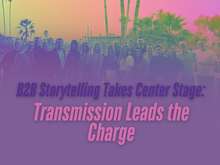The Art of Editing: Long-Form Storytelling vs. Short-Form Spots
- Jordan Kelley
- Nov 6, 2024
- 3 min read
Updated: Nov 12, 2024
Hather Danosky, Editor at Bandit

Want weekly exclusive brand storytelling content like this direct to your inbox? Subscribe to the Brand Storytelling Newsletter.
As an editor in the world of visual storytelling, I’ve worked on a wide variety of short and long-form commercial and branded content, as well as music videos and documentary films. While each format requires a slightly different approach, the ultimate goal remains the same: establishing an emotional connection. Whether it’s the more immersive emotional arc of long-form storytelling or maintaining the ability to create a precise, impactful punch of short spots, that emotional connection is my north star.
I aim for the viewer to fall in love with the footage the same way I did. Having the advantage of knowing the full story from the dailies, I use emotion as a guide when cutting every spot or film. Something so personal happens during the selects process because you’re seeing the footage for the first time and reacting to the way that you feel upon that first introduction. The emotional attachment to the story I’ve been trusted to tell starts there.
Long-form in many ways provides a richer canvas for emotional storytelling. There is space for complex narratives to come through and greater opportunities for the audience to step inside of that world. There’s a certain freedom in long-form projects, which makes the process both exciting and daunting. One concept that is especially challenging yet necessary in long-form branded content, and that has always stayed with me—introduced by my good friend and director Frank Pavich—is "kill your darlings." For me, this sentiment means that I’m so in love with a shot, character, or idea that the thought of it ending up on the cutting room floor is a non negotiable. Deep down I realize it doesn’t fully work for the story so I’ll eventually come to terms with killing it. It’s a brutal yet gorgeous part of the process, and I take this idea with me when approaching all my projects. Even short spots.
Short spots demand a more precise way of storytelling, and there is a real beauty in where you land with those projects because those are situations where it can come down to the frame. These constraints push my creativity even further. It’s thrilling getting ruthless with the footage.There’s not as much time for extensive build-up, so the message needs to hit hard and fast. There is a rhythm I get into that allows the spot to unfold naturally. I know when I’ve hit it. And often, the "rulebook" goes out the window as I experiment with unconventional techniques to leave a lasting impression.
In long-form projects, the team can be more deeply invested in the narrative. Whereas for short spots, often the focus is on immediate impact and the execution of a specific message. There are rewards in all of these experiences, but when the relationship clicks with everyone on board, you know you have something powerful.
Ultimately, whether it's long-form content or a quick spot, the goal is to provoke emotion and create something that resonates. Both formats offer moments of beauty and challenge me to continually refine my craft. Editing long-form content requires patience and a willingness to let the story breathe, while short-form spots demand sharp focus and the ability to distill a message to its core. My good friend and editing soulmate, Eilish Boyd, always says, 'No one is gonna cut a spot the way that you do.' She’s right, no one can. I strive to leave a unique footprint on my work, ensuring the best possible product regardless of length.
About Heather Danosky:

Heather is an NYC-based editor specializing in high-profile short and long-form commercials and branded content. Most recently, she’s done work with agencies like Edelman, Mother, Grey, Weber Shandwick, MBooth and Droga5 working on campaigns for brands like Esty, Pure Leaf, Hellmann’s, Patron, Nexxus, Seventh Generation, Dove, Venus to name a few. She has collaborated recenwith directors Eva Zar, Jillian Martin, Kelsey Taylor, Cody Cloud, Sergii Shevtsov, among many others. In addition to commercial work, she’s also worked on a number of music videos and documentary films, and furthers her passion for filmmaking through her own production company, Lean-To Pictures.













